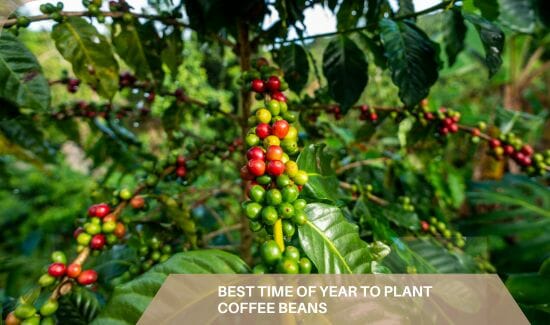
Are you a coffee lover who dreams of sipping your own homegrown brew? Well, it’s time to turn that dream into a reality! Growing coffee beans may seem like a daunting task, reserved only for experienced farmers in far-off lands. But fear not, my fellow caffeine enthusiasts! With these simple hacks, you can successfully cultivate your very own coffee beans right at home. So grab your gardening gloves and get ready to embark on an exciting journey into the world of Java cultivation.

What You’ll Need to Grow Coffee Beans
Growing coffee beans at home can be a rewarding and fulfilling experience. To set yourself up for success, there are a few essential things you’ll need to get started.
First and foremost, you’ll need coffee beans! Look for high-quality Arabica or Robusta coffee seeds from a reputable source. These will ensure that you have the best chance of growing healthy plants.
Next, consider the climate in your area. Coffee plants thrive in tropical climates with temperatures between 60°F and 70°F (15°C to 24°C). If you live in a colder region, you may want to grow your coffee plants indoors or use containers that can be moved inside during the winter months.
In addition to the right seeds and climate conditions, good soil is crucial for successful coffee bean cultivation. Coffee plants prefer well-draining soil with a pH level of around 6.0 to 6.5. You can enhance your soil by adding organic matter such as compost or aged manure.
To provide proper hydration for your coffee plants, make sure they receive regular watering. Keep the soil moist but not overly saturated to prevent root rot. Investing in a drip irrigation system or using mulch around the base of each plant can help regulate moisture levels.
Coffee plants also benefit from regular fertilization throughout their growth cycle. Opt for a balanced fertilizer specifically formulated for acid-loving plants like azaleas or rhododendrons. Apply it according to package instructions every two to three months during the growing season.
Patience is key when it comes time to harvest your precious coffee cherries! Depending on the variety and growing conditions, it can take anywhere from three to five years before your first harvest is ready.
Remember these essential ingredients: quality seeds, suitable climate conditions, well-draining soil enriched with organic matter, proper watering techniques, and regular fertilization schedule – all combined with lots of patience – and soon enough you’ll be enjoying freshly brewed coffee made from your very own beans!

The Best Soil for Growing Coffee Beans
The quality of soil plays a crucial role in the successful growth of coffee beans. When it comes to cultivating your own coffee plants, choosing the right soil is essential for their healthy development.
Coffee plants thrive in well-drained soils that are rich in organic matter. They prefer slightly acidic soil with a pH level between 6 and 6.5. Sandy loam or loamy soil types work best for growing coffee beans as they provide good drainage while retaining moisture.
To create an ideal environment for your coffee plants, consider adding compost or well-rotted manure to improve the soil’s fertility and structure. This will help retain moisture and nutrients, promoting optimum growth.
Additionally, incorporating organic matter into the soil helps enhance its water-holding capacity, allowing the roots to access water during dry spells without becoming waterlogged during heavy rainfall.
Remember to avoid using heavy clay soils or those prone to waterlogging as these can lead to root rot and hinder proper plant development.
By selecting high-quality soil with good drainage and providing adequate nutrition through organic matter amendments, you’ll be setting your coffee beans up for success!

The Best Time of Year to Plant Coffee Beans
The timing of planting coffee beans plays a crucial role in ensuring a successful harvest. Coffee plants thrive in warm climates, and they are sensitive to frost and extreme temperatures. Therefore, it is essential to choose the right time of year for planting.
Ideally, coffee beans should be planted during the spring or early summer months when the soil temperature rises above 60 degrees Fahrenheit (15 degrees Celsius). This allows the seeds to germinate quickly and establish strong roots before facing harsh weather conditions.
In regions with mild winters and consistent temperatures throughout the year, such as tropical areas or greenhouses, coffee beans can be planted at any time. However, it’s still advisable to avoid extreme weather patterns like heavy rainfall or drought periods.
Before planting your coffee beans, consider your local climate and consult with experienced growers or agricultural extension services for specific recommendations tailored to your region. They will have valuable insights into the best times for planting based on local weather patterns.
By selecting the optimal time of year for planting coffee beans, you give them a head start in establishing healthy roots that will ultimately lead to a bountiful harvest down the line.

How to Water Coffee Beans
Watering your coffee beans is an essential part of their growth and development. Proper watering techniques will help ensure healthy plants and a bountiful harvest. Here are some simple tips on how to water your coffee beans effectively.
It’s important to understand that coffee plants require consistent moisture but not excessive watering. Overwatering can lead to root rot and other issues, so it’s crucial to find the right balance.
When it comes to watering frequency, aim for regular but moderate irrigation. The soil should be kept evenly moist without becoming waterlogged. In general, you’ll want to water your coffee beans about once or twice a week, depending on the weather conditions and soil type.
To determine when your plants need watering, check the moisture level in the top few inches of soil. If it feels dry to the touch, then it’s time to water them. However, if the soil feels damp or moist already, hold off on watering until it dries out slightly.
When you do water your coffee beans, make sure you’re using room temperature or lukewarm water rather than cold water from the tap. Coldwater shock can harm delicate roots and slow down plant growth.

How to Fertilize Coffee Beans
Choose a balanced fertilizer specifically formulated for coffee plants. Look for one that contains nitrogen, phosphorus, and potassium (N-P-K), as these nutrients are vital for the overall health of your coffee plants.
When applying the fertilizer, be sure to follow the instructions on the package carefully. It’s important not to over-fertilize your plants as this can lead to nutrient burn or stunted growth.
One effective method is to apply a slow-release fertilizer around the base of each plant. This allows for gradual nutrient release over time, providing a steady supply of nourishment without overwhelming the roots.
Another option is foliar feeding, which involves spraying a diluted liquid fertilizer directly onto the leaves of your coffee plants. This method allows for quicker absorption of nutrients by the foliage.

How to Harvest Coffee Beans
Harvesting coffee beans is an exciting and rewarding process that marks the culmination of your hard work. When it comes to harvesting coffee beans, timing is everything. The best time to harvest coffee beans is when they are fully ripe, which can vary depending on the specific variety you are growing.
To determine if your coffee cherries are ready for harvest, look at their color. Ripe cherries will be a deep red or purple hue, signaling that they are full of flavor and ready to be picked. Using your fingertips or a pair of shears, gently remove the ripe cherries from the branches one by one. Once you have collected a batch of freshly harvested coffee cherries, it’s time to begin processing them.
There are two primary methods for processing coffee:
- Wet processing.
- Dry processing.
Wet processing involves removing the outer skin and pulp from the cherry before drying the beans. Dry processing involves allowing the entire cherry to dry naturally in the sun before separating out the beans.
After processing, it’s important to properly store your harvested coffee beans in a cool and dry place until they can be roasted. This will help preserve their freshness and ensure that you get maximum flavor when it’s time for brewing.
Conclusion
By following these simple hacks on how to grow coffee beans, you can enjoy the satisfaction of growing your own delicious cup of joe right at home! So go ahead and give it a try – who knows, you might just become an expert barista in no time!
Remember to gather all the necessary supplies before getting started. You’ll need coffee bean seeds, good-quality soil, and containers with drainage holes. Make sure to choose the right type of soil for optimal growth.
FAQs About How To Grow Coffee Beans
Q: Can I grow coffee beans indoors?
A: Yes, you can definitely grow coffee beans indoors! Just make sure to provide them with the right conditions of sunlight, temperature, and humidity.
Q: How long does it take for coffee plants to bear fruit?
A: Coffee plants typically start bearing fruit after about three to four years of growth. Patience is key when cultivating your own coffee beans!
Q: Do I need to roast the coffee beans myself?
A: It’s up to you! If you’re a true coffee aficionado, roasting your own beans can be a rewarding experience. However, if you prefer convenience, there are plenty of places where you can have your homegrown beans roasted for you.
Q: Are there any pests or diseases that affect coffee plants?
A: Yes, like any plant, coffee trees can be susceptible to pests such as aphids and diseases such as leaf rust. Regular monitoring and proper care will help prevent or manage these issues effectively.
Q: Can I use store-bought green (unroasted) coffee beans to grow my own plants?
A: Absolutely! In fact, using green unroasted beans from reputable sources is often recommended for growing your own coffee plants.

As a dedicated blogger, I share insights, tips, and knowledge on all things caffeinated and beyond. I firmly believe that a well-brewed cup of coffee or a skillfully crafted cocktail has the power to unite people and ignite engaging conversations.



